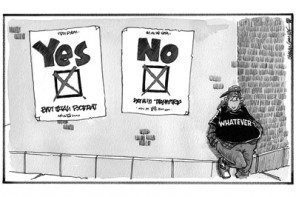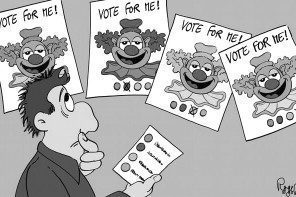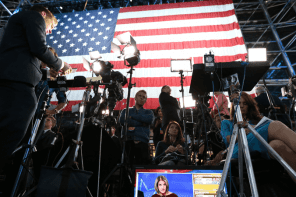On November 8, 2016, man who consistently and unapologetically used racist, xenophobic, islamophobic, and sexist rhetoric throughout his campaign was elected by the American public to be the next President of the United States.
This is not surprising to many people of color.
Shortly after midnight the morning of August 19, 2015 Guillermo Rodriguez, a homeless man of Mexican birth, was assaulted by brothers Scott and Steve Leader in Boston, Massachusetts . Mr. Rodríguez was beaten with a metal pipe and urinated on. The Leader brothers told law enforcement officials at the scene of the crime that “All these illegals need to be deported,” parroting comments made last June by US Republican presidential candidate. This candidate, who would go on to win the November general election, announced his candidacy by stating –
When Mexico sends its people, they’re not sending their best…They’re bringing drugs. They’re bringing crime. They’re rapists. And some, I assume, are good people.
These comments went viral and their implication, that Mexican immigrants are responsible for waves of crime, became a hallmark of the president-elect’s campaign. Despite reports indicating that immigrants are less likely to break the law than their native-born counterparts, this rhetoric caught on like wildfire amongst the candidate’s supporters, including Scott and Steve Leader. These sentiments are neither new nor were they uniquely conceived by the president elect. Immigrants have been scapegoated for everything ranging from economic downturn and urban violence to the Swine Flu and Car accidents . Additionally, there have been efforts to force out Mexican immigrants since days of the 1930s repatriation efforts and 1954’s horrifically-named “Operation Wetback.”
However while America is no stranger to xenophobia, there was something novel about those June comments: they were spoken brazenly by a candidate for the highest office in the United States. It is important to note, that the man who spoke those words in June 2015; the man who called to ban Muslims from entering the United States; the man who seeks to implement militarized police practices to target and violate the constitutional rights of black and brown men and women ; the man who questioned the citizenship of the first black president of our country; the man who reaped the benefits of an endorsement from the Klu Klux Klan; the man who will become the 45th President of the United States of America never denounced his supporters, the Leader brothers, for their assault on Mr. Rodriguez. When informed of the impact his words had on Scott and Steve Leader, the president-elect simply stated that “the people that are following me are very passionate. They love this country; they want this country to be great again.”
The signature promise of the winning campaign for the American presidency was to Make America Great Again. These four words capture the resentful sentiments of certain segments of the population that the United States is not moving in the right direction. Specifically, the country was not moving in the right direction under the leadership of its first black president, Barack Obama. While the two-time election of President Barack Obama was largely a source of pride for many Americans, large swaths of the populace were fearful of what the President symbolized and were distrustful, often resentful, and sometimes hateful towards the people who elected him. President Obama was gingerly carried into office by racial minorities, young adults, and the college educated. This happened in 2008 and again in 2012. Many predicted another victory for the Democrats in 2016, in large part due to a changing racial landscape in the United States.
The United States Census Bureau released a report on the changing demographics of the American populace on June 25, 2015. The report revealed that for the first time in the modern history of the United States, a minority of the population would identify racially as “white.” Black, non-White Latino, and Asian children have surpassed white children as the largest group of American children under 5 years old. The Census Bureau expects this trend to continue and projects that the United States’ era of a White majority will end in 2044. Along with the rise in births of minority children born in the U.S., the percentage of the foreign-born population will also surge. The Census Bureau reports that the growth rate of the foreign-born population outpaces the growth rate of the native-born population and projects that by 2060 nearly 20 percent of the United States population will be of foreign birth . This trend toward minorities eclipsing the majority was what led many to believe that the 2016 election would swing in the favor of Democratic Candidate former Secretary of State Hillary Clinton. With more young racial minorities and young liberal whites coming of age during this election, Secretary Clinton was predicted to win the election and waltz into the White House in the most dazzling of pantsuits. Of course these events did not take place, leaving many liberal Americans scratching their heads, wondering how this could happen here.
That this happened here was not surprising to many people of color.
This is not surprising to many people of color living in this country because a great many of us have been made to understand that we are not America personified. For evidence of this, we need look no further than our most treasured past-time—American football. On August 26, 2016 San Francisco Forty-Niners quarterback, Colin Kaepernick, chose not to stand with his teammates as the “Star Spangled Banner” bellowed over Levi’s Stadium in Santa Clara, California. Kaepernick’s choice to remain seated was a form of protest against police officers disproportionately killing and harassing unarmed black people with impunity. His protest subverted one of the most basic forms of acting out American patriotism, standing for the national anthem, to draw attention to black Americans being denied their civil rights as U.S. citizens. When asked about his choice to sit during the national anthem, Kaepernick stated –
“At what point do we take a stand and, as a people, say this isn’t right? You (the police) have a badge and you’re supposed to be protecting us, not murdering us.”
This not-so-recent phenomenon of law enforcement officials harming or taking black lives, often with no evidence of physical provocation , sparked public discourse about police brutality and the grassroots movement Black Lives Matter. Black Lives Matter aims to affirm that black American lives are just as valuable as that of any other American. The necessity of a movement whose goal is to awaken the American populace to the fact that black American lives do indeed have value is indicative of the way black people, and other people of color, are treated in the United States. According to the U.S. National Bureau of Economic Research, law enforcement officials are more than fifty percent more likely to use some form of physical force, including hand-cuffing, pepper spraying or pointing their weapons, against black and Latino individuals. Further, in several U.S. cities, black and Latino individuals are disproportionately on the receiving ends of bullets fired by police officers. In Oakland, California out of 45 officer-involved shootings in the city between 2004 and 2008, 37 of those shot were black—a rate of 82 percent in a city where black people constitute 28 percent of the population. The New York Police Department reported that although blacks and Latinos are 52 percent of New York City’s total population, they represented 85 percent of those fired on by police in 2011. And in the event that a black or Latino person is killed at the hands of a police officer, the officer involved will likely never face conviction or sentencing. Delores Jones-Brown, a law professor and director of the Center on Race, Crime, and Statistics at the John Jay College of Criminal Justice in New York City told Mother Jones in August 2014:
“The police don’t show as much care when they are handling incidents that involve young black men and women, and so they do shoot and kill…and then for whatever reason, juries and prosecutor’s offices are much less likely to indict or convict.”
This unwillingness to hold police officers accountable in the event of their wrongdoing often means that black and brown people shot or otherwise harmed by the police will never see those who wronged them brought to justice. This phenomenon is further evidence of black and brown individuals’ American citizenship being called into question.
American school children across the nation begin their day repeating thirty-one words intended to convey the speaker’s affirmation of the values and freedom granted them by virtue of their citizenship in the United States—the pledge of allegiance. The words of this promise of love for country are as follows:
“I pledge allegiance to the flag of the United States of America, and to the republic for which it stands, one nation under God, indivisible, with liberty and justice for all.”
The pledge of allegiance guarantees an America that is indisputably united under the glory of God and that benevolently endows all of its citizens with “liberty and justice for all.” However, when it has been made clear that “justice for all” does not extend to the black and brown victims of police brutality and excessive force, what, then, must black and brown Americans make of their citizenship in the United States, when they continually see the killers of people who look like them getting off with little more than paid administrative leave? The answer, of course, is up to those black and brown individuals to negotiate for themselves, for one person cannot speak for all members of a group. There may be a great number of people of color who see these events as having nothing to do with them whatsoever. However, their distance from this issue does not erase the pain and stress that many people of color feel when they are reminded that the civil rights guaranteed to American citizens–liberty and justice for all– will not always be extended to them in their homeland.
The days following the 2016 election have seen an increase in hate crimes across the country. In the three days after the election, the Southern Poverty Law Center received reports of 201 hate crimes many of them directed at black and brown individuals, Muslims and immigrants . By Monday, November 14, the number of reported instances of hate and harassment that referenced the president-elect’s campaign had risen to 437. One report detailed a young 20-something Latino man having garbage thrown on him and being told to “go back where [he] came from.” Additionally, one 12 year-old school girl was reportedly approached and told:
“now that Trump is president, I’m going to shoot you and all the blacks I can find”
Relevant: THE ROLE OF MEDIA, RACE, AND GENDER IN US ELECTION 2016
These attacks are alarming, but they are not a new phenomenon. The hatred behind these actions are a symptom of the United States’ long history of suppressing the rights of people of color. Throughout his campaign, the president-elect exploited this hatred and, whether intentionally or not, attracted the support of the support of white American supremacists, like David Duke and William Johnson. Whether the president elect truly believes the racist, xenophobic and islamophobic rhetoric he spewed during his campaign is beside the point. He used his platform to stir the hatred of many Americans and will likely enact legislation that will suppress the rights of people of color, as many have done before him. And once again, people of color must be ready to rise and fight for our civil liberties.
About the Author
Migration Policy Institute, USA






